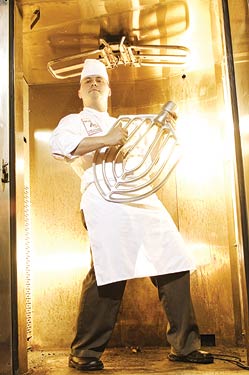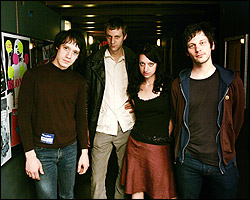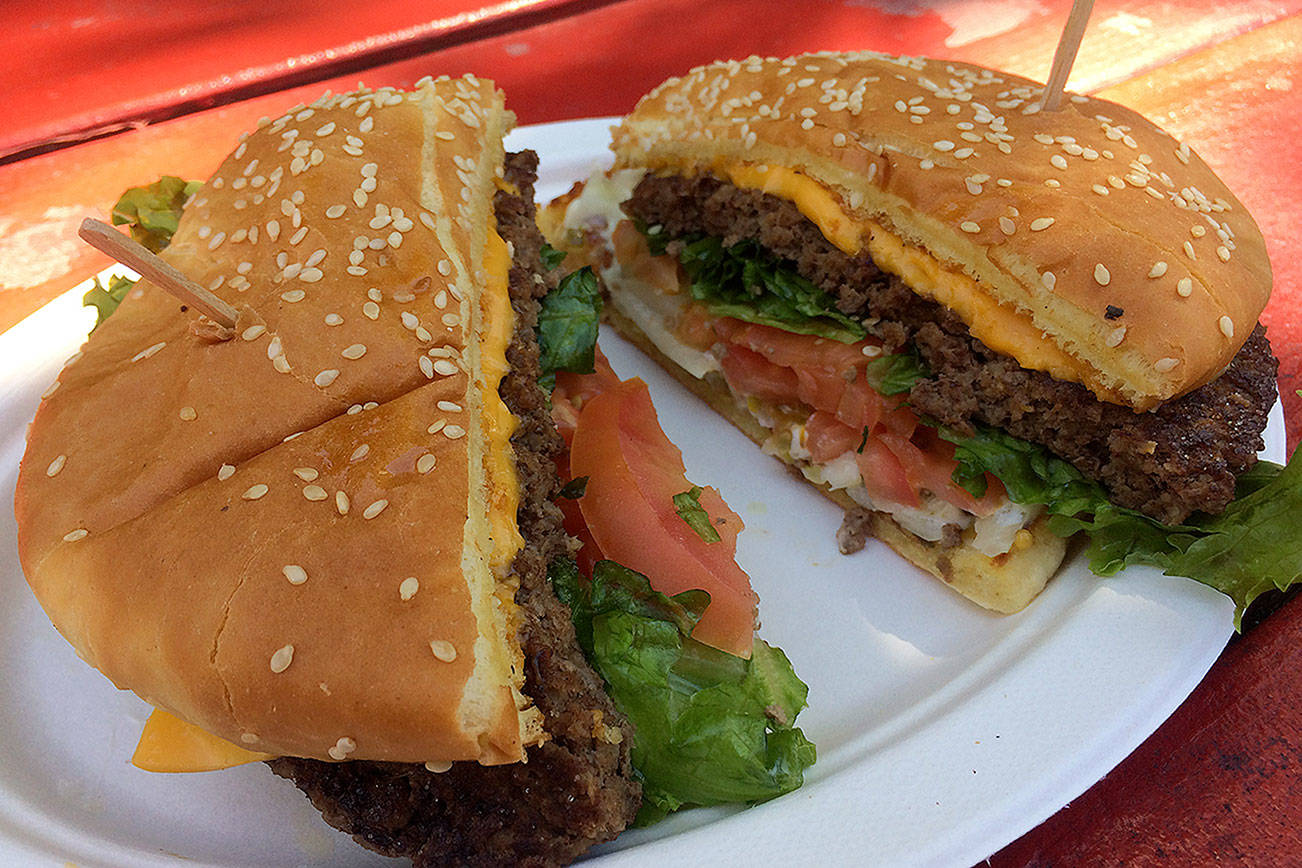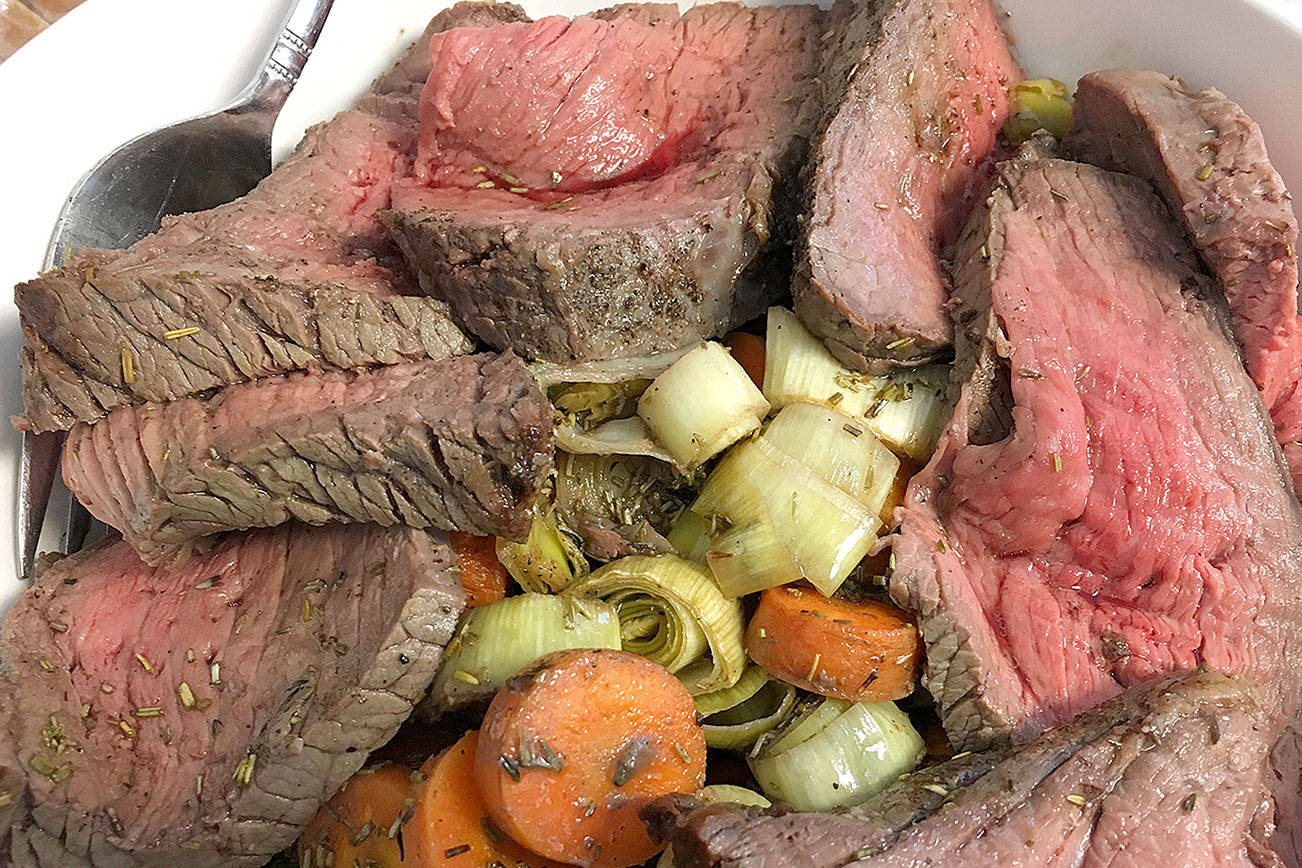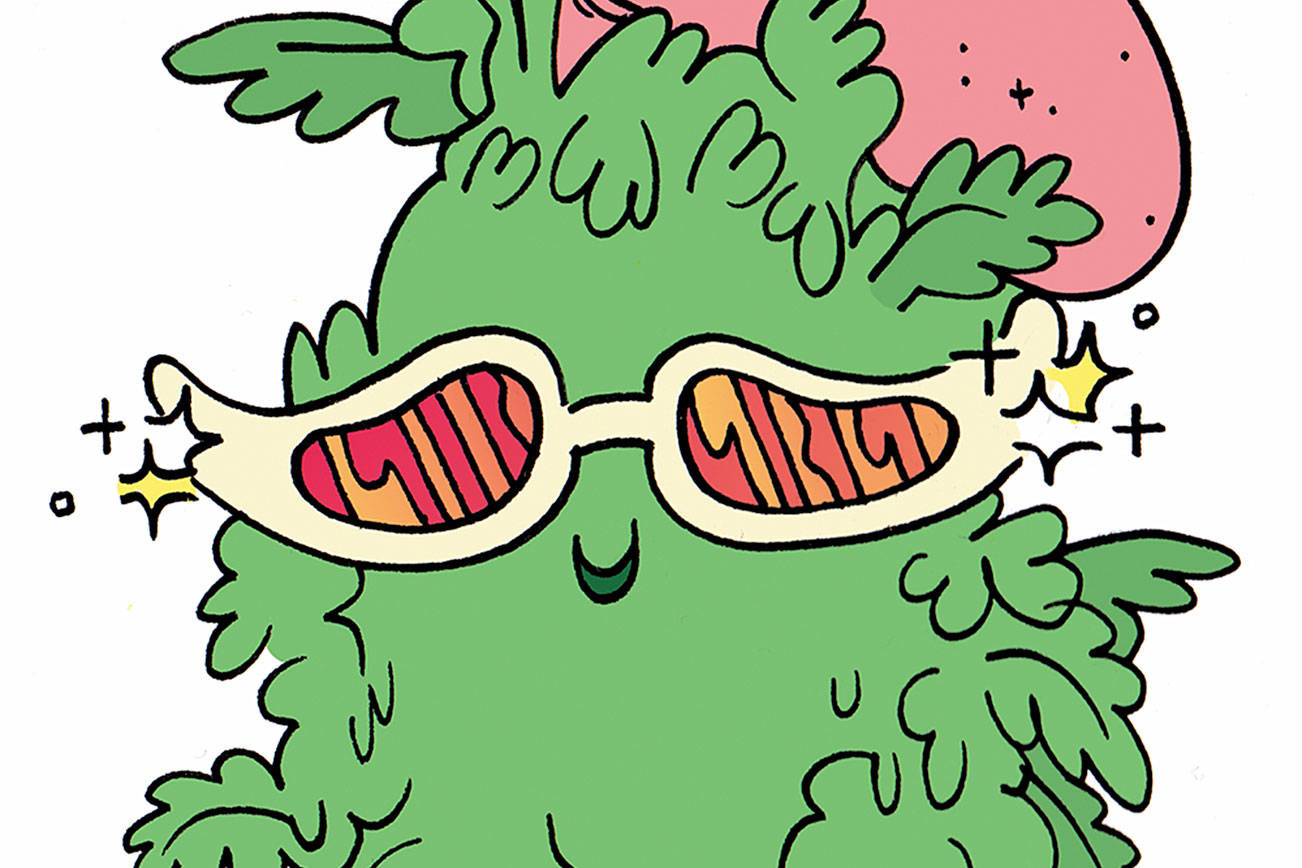If you didn’t live through it, it’s hard to believe that there was a time when handmade, hearth-baked breads just weren’t available in Seattle. No crackly crusted loaves of olive bread, no rounds of sour white, not even much in the way of a baguette. Call them the dark days of bread; that’s how longtime Seattle food industry folks remember them. We had become a nation whose notion of bread meant bland, gluey white stuff—presliced, prepackaged, mass produced, and meant to stay fresh for weeks. Twenty years ago, if you wanted a freshly baked, hand-shaped European-style country loaf to serve with pasta, well, you probably had to make it yourself.
Fast-forward to the present. We’re living in what Gina Piccolino, executive director of the Bread Bakers Guild of America, calls a “hotbed of artisan bread making”—complete with our own world-champion baker: Essential Baking Company’s William Leaman, who led this year’s winning team at the World Baking Cup in France, beating the French at their own game. As we speak, Leaman is preparing to vie for yet another world title. On July 6 and 7, he and his teammates will compete at the National Pastry Team Championship in Phoenix; if they win, they’ll represent the United States at the World Pastry Team Championship.
The rise of bread baking in Seattle tells us something about the city’s emergence as a haven for culinary craftspeople and its arrival on the national food scene. The story begins in the late ’80s, when a micro-movement of pioneering bread bakers, a teenager with an epiphany, and a climate and culture perfect for baking unwittingly conspired to make the dark days of bread a thing of the past.
Artisan Breads, Not Wells
 (Rick Dahms) (Rick Dahms) |
When Gwen Bassetti opened Grand Central Bakery in 1989, she and her crew of bakers—then headed by Leslie Mackie, who now owns Macrina Bakery and Cafe—joined a handful of Seattle bakers who were quietly persisting with mostly French-style breads. Although this small faction of bakers was practicing a careful craft, no one called the bread “artisan” at the time. Bassetti remembers that it wasn’t until years later at a national meeting of the Bread Bakers Guild—a trade organization that works to promote, support, and educate bakers and bakeries in the United States—that the term was agreed upon. She recalls Julia Child, “who was then entering her dotage,” straightening herself up and announcing that in her day, “artisanal” referred to wells drilled into the earth to tap water. At that time, most of the country didn’t even know it was missing the breads and cheeses that would eventually be described in this manner.
Italian-born early Microsoftie Ciro Pasciuto knew what he was missing, though. He started La Panzanella the same year that Bassetti opened Grand Central because he couldn’t find any bread that reminded him of the thick-crusted, irregularly shaped loaves that were made in virtually every kitchen in his hometown of Gaeta.
A few years earlier, Steve Sullivan had opened Acme Bakery in Berkeley, Calif., after becoming inspired in the kitchen of Alice Waters’ seminal Chez Panisse. “What has now been called the bread revolution happened almost universally across the country at the same time,” says Bassetti. Although she says she “didn’t think [she] had a hold of what would be a big craze,” Seattle food lore credits her with the local sea change.
In the beginning, education was as important as baking. Grand Central’s first customers complained that the crust was burned, or that the relatively dry texture of the chemical-free loaves tasted stale. Eventually, the local press and then national food industry magazines began to help inform communities about what it was they were eating.
Despite the early learning curve, the market for rustic and old-world breads is now huge. Local baguette and specialty bread baker A la Francaise was purchased by Sara Lee Bakery in 1999; Grand Central bakes as many as 6,000 loaves of bread per day in Seattle alone (and operates in Portland as well); and Fred Meyer and Safeway advertise their own “artisan bread” lines. At Jack in the Box, you can order a cheeseburger on ciabatta. As mass marketed as old-world breads now are, and as much as some of the early pioneers have progressed, it would be easy to lose sight of what it means to say that something is artisanal if Seattle weren’t so rich with truly artist-crafted, purely made breads.
Here, loaves are hand-shaped by mindful bakers, from small bakeries like La Boulangerie, now owned and operated by Vietnamese immigrant Xon Danh Luong, where just one man makes every loaf of savory herb campagne bread and each flaky, buttery croissant—and sells almost all of it, too (he employs only part-time counter help on holidays and some weekends)—to Macrina, where the cafe culture is as noteworthy as the supremely tender and earthy rustic potato bread that Leslie Mackie is well known for. Touching the living dough, knowing it like they know any other living, changing, valued thing, and worrying over it—sensing the nuances of each loaf and making minor adjustments—this is the fundamental action of bread makers.
You can taste the authenticity and vision in the crackly crusts that surround the light, airy baguette and the slightly sweet, exquisitely flavored walnut, or noix, loaf from Le Panier and the seedy, toothsome Parisian baguette from Essential. Dahlia Bakery’s ficelle, a crusty, skinny version of baguette, inspires dreams of France; the Touchstone Bakery collective creates wholesome, substantial loaves; Grateful Bread’s Struan loaf has a rich history and a rich taste; North Hill Bakery’s whole wheat makes exceptional sandwiches, and the just slightly acidic (don’t say sour) pain au levain at Wild Wheat Bakery in Kent is well worth the drive.
Any of these exceptional breads could be compared against the French standard, Poilâne. Made with just whole wheat flour and water, the deceptively simple bread sets the example of what modern, old-fashioned bread should be, and Metropolitan Markets fly it in every Thursday from France. I can’t say I recommend Poilâne above anything that’s made here, but the renowned bread provides a good control sample for taste testing, and it offers a good perspective on the standards for world-famous bread.
And just as Poilâne typifies European peasant bread, its now-deceased creator, Lionel Poilâne, studied under his father starting at the age of 14 and typifies the old-world apprentice. As it happens, Seattle’s world-class baker provides a romantic example of an old-world apprentice, too.
A Baker’s golden age
 Being a baker means resigning yourself to wakefulness while the rest of the world sleeps. (Rick Dahms) Being a baker means resigning yourself to wakefulness while the rest of the world sleeps. (Rick Dahms) |
William Leaman knew at age 14 that he was going to be a baker. As Leaman and I sat in the loft office overlooking Essential Baking Company’s Fremont-Wallingford bakery, he even recalled the exact time and date.
On the afternoon of June 4, 1988, Leaman and his father visited a German bakery owned by a family friend in their Arkansas town. Although he was barely a teenager at the time, he was strongly drawn to the complexities of fermentation and the warm, earthy smell of the dough. He knew right away that he would spend the rest of his life being awake while almost everyone else was sleeping.
Labor laws were different then—and small Southern towns often seem to operate under their own directives, anyway—so Leaman began on the night shift right away. He got to the bakery at 10:30 at night and worked until about 7 in the morning before going to school. Even with all the energy of a young teenager, this schedule quickly proved to be too much. His morning classes were chemistry and biology (which is nice synergy, considering those two subjects are integral to baking), but by third period, he was asleep in his books.
The image of a spent young tradesman falling asleep before noon fits well with those whimsical impressions we have of old-country apprentices, but it’s not likely that Leaman (who is about as practical and modest a world champion as you’re ever likely to find, regardless of the field) had such romantic thoughts when his father offered him this deal: William could forgo school and get his GED in order to continue working at the German bakery and help support the family, while his father went back to college. Later, his father would help put him through school. Leaman accepted, aced the GED in short order, and never looked back.
By age 19, he had his own bakery and was reading every baking book he could get his hands on; he particularly remembers The Professional Pastry Chef by Bo Friberg. In 1996, he came to Seattle to visit a friend who had recently moved here, and after sitting on the beach at Alki and watching tugboats for a few days, Leaman decided to move here, too. He worked first in restaurants and then at Essential, developing their pastry program. Over the next few years, he left town for extended periods to take courses at the Culinary Institute of America at Greystone (in California’s Napa Valley) and at the now defunct National Baking Center in Minneapolis. In 1999, he was selected to assist pastry chef Jean-Claude Canestrier at the brand-new Paris Hotel in Las Vegas. After two years of endless croissants and urgent calls from the concierge to create difficult spun-sugar showpieces and trays of elaborate little cookies to help patrons either celebrate their victories or mourn their losses, he returned to Seattle and to Essential.
Working under the world-renowned Meilleur Ouvrier de France, or MOF (an industry distinction denoting an elite, master class of pastry chefs), in a large-scale hotel, Leaman’s Las Vegas experience was like baker’s boot camp, an intensive pastry-chef skull session. But one of the most important things that he took from the Paris Hotel had to do with a different aspect of the trade. “Jean-Claude did a lot of competing,” Leaman says, “and he never lost any competition he entered.”
At the end of our second interview, which took place about a month after Leaman returned with his Stanley Cup–like bread trophy, he offered to loan me a DVD of World Baking Cup. It’s the documentary of the 2002 Coupe du Monde de la Boulangerie, or the World Cup of Baking, that the Food Network recently aired; he called the film “exciting” even though he also jokingly admitted that it’s a bunch of bakers standing around literally watching dough rise.
At 32, there’s still a lot of the young apprentice in Leaman. Handing me the DVD, he reminded me of a top-ranking high-school quarterback with a tape of the most famous Super Bowl win ever. Boyish and modest, Leaman has a real affinity for his trade and is absolutely captivated by the idea of being the best at it—but not in a way that loses sight of the, well, essential nature of his craft.
Birth of a Food Culture
 Baker Heath McReynolds toils at the all-organic Tall Grass Bakery. (Rick Dahms) Baker Heath McReynolds toils at the all-organic Tall Grass Bakery. (Rick Dahms) |
So how did our just-barely-out-of- short-pants bread-making community grow to include a world champion? Speaking to me over the phone from her farm, Gwen Bassetti said the city simply hit its stride and grew up in the last year of the ’80s. She points out that at the same time Grand Central began, Tom Douglas was opening his first restaurant and the Queen Anne Thriftway was offering an alternative to dreary, overlit grocery aisles. “Just look where those organizations are now,” she offered.
At about the same time, Starbucks was becoming the giant it is today; locally made microbrews were showing up next to national brands on the taps; and east of the mountains, Washington wineries were practicing their own old-world craft. Go out a little further: Nirvana was the best band in America and Microsoft, a publicly traded company since 1986, was a household name. Maybe it was a tipping point—or maybe we can just blame the weather: It definitely plays a role in baking excellent bread.
George DePasquale, who helped found Essential Baking in 1994 and is now the head baker (Leaman heads the pastry department), says the best example is America’s most famous one. According to him, San Francisco’s very specific microclimate allows for unique strains of yeast, which in turn allow for the unique San Francisco sourdough bread. There are wild yeasts in the air everywhere, but those in foggy San Francisco—the ones that bakers capture by mixing flour and water and allowing the mixture, which is then becoming starter (or, depending on whom you’re talking to, “chef,” “mother,” or about half a dozen other euphemisms), to literally come alive—aren’t strong enough to compete with other wild yeasts, and they don’t survive for long outside of their city. (Next time you’re at a dinner party and someone tells you the bread was made from starter smuggled from a recent weekend in the Bay Area, don’t expect it to taste as acidic and complex as it would in its natural environment— unless it’s Monday and your friends have a Lear jet.)
Some bakers say that you can’t culture a proper starter in urban environments, but there are some expert bakers in New York City who would beg to differ. Seattle’s climate isn’t as specific as San Francisco’s, or as characterized by steel and concrete and inorganic matter as New York’s, but our weather affects our bread making, too.
DePasquale says our consistent weather gives us a great climate for baking. The air pressure is even, which allows for consistency as the dough rises, from minute to minute and from month to month. The humidity is just right; with no moisture in the air, a crustlike skin will start to develop on the dough way before you want it to—they don’t bake a lot of rustic bread in Arizona. And, finally, the relatively small number of really hot days means that bakers only infrequently have to worry that the fermentation process is happening too quickly. DePasquale, a mostly self-taught baker who grew up in an Italian-American home in New York, is a no-nonsense person who prefers bread without “inclusions” (baker-speak for stuff like rosemary and olives). To him, crust is what ultimately makes the bread.
“I like it just this side of burnt. I like to use the word ‘burnished,'” he told me. Essential’s Columbia loaf is his favorite because it epitomizes an excellently dark and crusty bread. “To me, the perfect crust is deep and enriched. It has the quality of being crunchy and chewy at the same time.”
As often as bakers talk about biology and air pressure, though, those who deal in hand-shaped loaves and slowly leavened breads talk about having a one-on-one relationship with their customers. They can really have that in a city like Seattle, where the pace is relatively slow and family life and neighborhoods are as common as takeout culture and as important as urban excitement. And Seattle—the new Seattle, full of transplants and new thinkers—is a city of early adapters.
This meshes perfectly with a comment that Macrina owner Leslie Mackiemade about the Coupe du Monde. “It was evident that Americans, because of their open-mindedness, could gather the best of all cultures,” she says of her impressions of the bread Olympics. Leaman recalls that at the World Cup, his team, which included Jory Downer of Bennison’s Bakeries in Evanston, Ill., and Jeffrey Yankellow of the San Francisco Baking Institute, was the only one that got up every morning at 4 a.m. to watch how their competitors worked. They weren’t spying or trying to steal secrets—and it probably would have been better strategy to get some sleep—they were simply interested in how other countries approached their breads.
It’s interesting to note that Japan has also been successful at the Coupe du Monde in recent years. What must the French think of Japan and America besting them on their own turf? Bread is not a part of Japan’s culinary history, but having become interested in finding new food products and looking to the French for inspiration, a new wave of Japanese bakers has developed some unusual ways of making it appealing to their public.
Our own openness to change and willingness to explore other cultures greatly contributes to Seattle’s status as a “hotbed of artisan making.” Where innovation and openness can thrive, everyone wins—bakers, chefs, and diners.
Bread and the City
 Tall Grass is one of only two bakeries in town that mill their grain themselves. The other is Great Harvest Bread. (Rick Dahms) Tall Grass is one of only two bakeries in town that mill their grain themselves. The other is Great Harvest Bread. (Rick Dahms) |
Tall Grass Bakery’s James Bowles is a Midwestern native who began selling bread at farmers markets in Iowa. After opening his Ballard bakery in 1999, he theorized that he’d have better luck selling baguettes to Seattleites at 6 p.m. rather than 6 a.m. Along with Great Harvest Bread, Tall Grass is one of only two bakeries in town that mill their grains themselves, which might not seem like a big deal to you until you think about grain as produce, and until you consider the difference between coffee that you brew after grinding your own beans and coffee you brew after opening a can of factory-ground beans.
Bowles and his crew epitomize the special relationship that culinary artisans can have with their community. He introduces his neighbors to new flavors and quality craftsmanship, and they respond by expecting the same quality and innovation from other merchants. If you had a picture from bread’s dark days of the stretch of 24th Avenue Northwest between Northwest Market Street and Northwest 65th Street or so—or even from 1999—it would look a lot different than it does today. Cafe Besalu, home of the best croissants in town, moved in next door soon after Tall Grass opened. On the same block, you can now find the Wine Shop on Twenty-Fourth, and down the street, there’s Dandelion, a small, seasonally focused restaurant that opened about a year ago. Where before the street was characterized by dive bars and burger joints, there’s now a discriminating, stylish but casual gourmandness to the neighborhood.
In the morning, folks congregate on the sidewalk outside Besalu and Tall Grass; if you’re unfortunate enough to be on your employer’s schedule and lingering is out of the question, it’s almost enough to break your heart. After work, when buses let young couples off near their homes and condos, the street has as much foot traffic and life as Belltown. Bowles won’t take any credit for this, but the Wine Shop’s Aaron Merkatz says Tall Grass was definitely one of the reasons he chose that location.
Watching an almost European scene wherein a woman with a baby strapped to her back buys a loaf of bread from Tall Grass and then ducks into the wine store for a bottle of something to go with it, the fundamental power of bread over its community is evident. Maybe it is a matter not of how our community grew or changed in order to support a culture of quality bread making, but of how quality bread making supports and changes our community.
